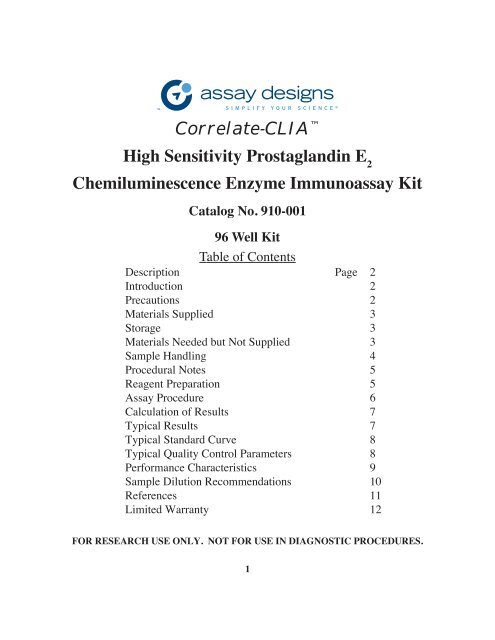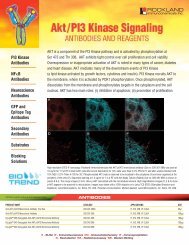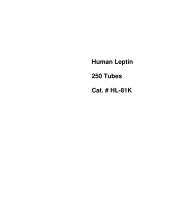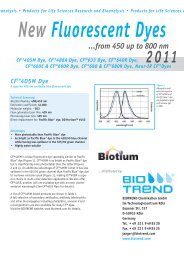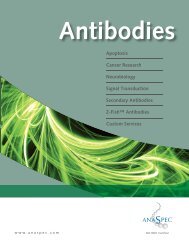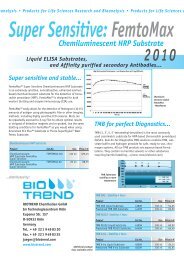910-001 PGE2 CLIA 6Dec06 - Enzo Life Sciences
910-001 PGE2 CLIA 6Dec06 - Enzo Life Sciences
910-001 PGE2 CLIA 6Dec06 - Enzo Life Sciences
Create successful ePaper yourself
Turn your PDF publications into a flip-book with our unique Google optimized e-Paper software.
Correlate-<strong>CLIA</strong> <br />
High Sensitivity Prostaglandin E 2<br />
Chemiluminescence Enzyme Immunoassay Kit<br />
Catalog No. <strong>910</strong>-<strong>001</strong><br />
96 Well Kit<br />
Table of Contents<br />
Description Page 2<br />
Introduction 2<br />
Precautions 2<br />
Materials Supplied 3<br />
Storage 3<br />
Materials Needed but Not Supplied 3<br />
Sample Handling 4<br />
Procedural Notes 5<br />
Reagent Preparation 5<br />
Assay Procedure 6<br />
Calculation of Results 7<br />
Typical Results 7<br />
Typical Standard Curve 8<br />
Typical Quality Control Parameters 8<br />
Performance Characteristics 9<br />
Sample Dilution Recommendations 10<br />
References 11<br />
Limited Warranty 12<br />
FOR RESEARCH USE ONLY. NOT FOR USE IN DIAGNOSTIC PROCEDURES.<br />
1
Description<br />
Assay Designs' Correlate-<strong>CLIA</strong> Prostaglandin E 2<br />
kit is a competitive immunoassay for the quantitative<br />
sensitive determination of Prostaglandin E 2<br />
in biological fluids. Please read the complete kit<br />
insert before performing this assay. The kit uses a monoclonal antibody to PGE 2<br />
to bind, in a<br />
competitive manner, the PGE 2<br />
in the standard or sample or an alkaline phosphatase molecule which<br />
has PGE 2<br />
covalently attached to it. After a simultaneous incubation at room temperature the excess<br />
reagents are washed away and chemiluminescent substrate is added. The substrate reacts with the<br />
bound alkaline phosphatase conjugate to produce light emission at approximately 530nm. The<br />
intensity of the emitted light is inversely proportional to the concentration of PGE 2<br />
in either standards<br />
or samples. The measured chemiluminescence is used to calculate the concentration of PGE 2<br />
. For<br />
further explanation of the principles and practice of immunoassays please see the excellent books by<br />
Chard 1 or Tijssen 2 .<br />
Introduction<br />
Prostaglandin E 2<br />
(PGE 2<br />
) is formed in a variety of cells from PGH 2<br />
, which itself is synthesized from<br />
arachidonic acid by the enzyme prostaglandin synthetase 3-6 . PGE 2<br />
has been shown to have a number<br />
of biological actions, including vasodilation 7 , both anti- and proinflammatory action 8,9 , modulation of<br />
sleep/wake cycles 10 , and facilitation of the replication of human immunodeficiency virus 11 . It elevates<br />
cAMP levels 12 and stimulates bone resorption 13 , and has thermoregulatory effects. It has been shown<br />
to be a regulator of sodium excretion and renal hemodynamics 14 .<br />
O<br />
Prostaglandin E 2<br />
COOH<br />
HO<br />
OH<br />
Precautions<br />
FOR RESEARCH USE ONLY. NOT FOR USE IN DIAGNOSTIC PROCEDURES.<br />
1. Some kit components contain azide, which may react with lead or copper plumbing. When<br />
disposing of reagents always flush with large volumes of water to prevent azide build-up.<br />
2. The activity of the alkaline phosphatase conjugate is dependent on the presence of Mg 2+ and<br />
Zn 2+ ions. The activity of the conjugate is affected by high concentrations of chelators, such<br />
as EDTA and EGTA. Please contact Assay Designs for further information.<br />
3. We test this kit's performance with a variety of samples, however it is possible that high levels<br />
of interfering substances may cause variation in assay results.<br />
4. The Prostaglandin E 2<br />
Standard provided, Catalog No. 80-0004, is supplied in ethanolic<br />
buffer at a pH optimized to maintain PGE 2<br />
integrity. Care should be taken handling this<br />
material because of the known and unknown effects of prostaglandins.<br />
2
Materials Supplied<br />
1. Goat anti-mouse Microtiter Plate, One Plate of 96 Wells, Catalog No. 80-0035<br />
A white plate using break-apart strips coated with goat antibody specific to mouse IgG.<br />
2. PGE 2<br />
<strong>CLIA</strong> Conjugate, 6 mL, Catalog No. 80-<strong>001</strong>3<br />
A blue solution of alkaline phosphatase conjugated with PGE 2<br />
.<br />
3. PGE 2<br />
<strong>CLIA</strong> Antibody, 6 mL, Catalog No. 80-<strong>001</strong>4<br />
A yellow solution of a monoclonal antibody to PGE 2<br />
.<br />
4. Assay Buffer, 30 mL, Catalog No. 80-<strong>001</strong>0<br />
Tris buffered saline containing proteins and sodium azide as preservative.<br />
5. Wash Buffer Concentrate, 30 mL, Catalog No. 80-1286<br />
Tris buffered saline containing detergents.<br />
6. Prostaglandin E 2<br />
Standard, 0.5 mL, Catalog No. 80-0004<br />
A solution of 50,000 pg/mL PGE 2<br />
.<br />
7. Lumiphos 530 <strong>CLIA</strong> Substrate*, 21 mL, Catalog No. 80-0134<br />
Alkaline Phosphatase substrate in diethanolamine buffer at pH 9.5, containing fluorescent<br />
enhancers, with sodium azide as preservative.<br />
8. PGE 2<br />
Plate <strong>CLIA</strong> Assay Layout Sheet, 1 each, Catalog No. 30-0039<br />
9. Plate Sealer, 1 each, Catalog No. 30-<strong>001</strong>2<br />
Storage<br />
All components of this kit, except the Conjugate and Standard, are stable at 4 °C until the<br />
kit's expiration date. The Conjugate and Standard must be stored at -20 °C.<br />
Materials Needed but Not Supplied<br />
1. Deionized or distilled water. No difference is seen in assay results with distilled water.<br />
2. Precision pipets for volumes between 5 μL and 1,000 μL.<br />
3. Repeater pipets for dispensing 50 μL and 200 μL.<br />
4. Disposable beakers for diluting buffer concentrates.<br />
5. Graduated cylinders.<br />
6. A micro plate shaker.<br />
7. Adsorbent paper for blotting.<br />
8. Plate luminometer, such as an EG&G Wallac LB 96P, capable of reading glow chemiluminescence.<br />
Some radiation counters may be suitable. Please refer to the counter instruction<br />
manual for recommendations on suitability for chemiluminescence measurements.<br />
*Lumiphos 530 is the trademark of Lumigen Inc., Southfield, MI, USA and supplied under US patents<br />
4,857,652; 4,983,779; 4,959,182; 5,004,565; 4,962,192, & 5,386,017; European patents 254051B1 &<br />
352713B1; Japanese patent 5-45590; Australian patent 603,736; Korean patent 69,259 and Taiwanese<br />
patent 46,563.<br />
3
Sample Handling<br />
Assay Designs’ Correlate-<strong>CLIA</strong> is compatible with PGE 2<br />
samples in a wide range of matrices.<br />
Samples diluted sufficiently into Assay Buffer can be read directly from the standard curve. Please<br />
refer to the Sample Recovery recommendations on page 11 for details of suggested dilutions. Samples<br />
containing mouse IgG may interfere with the assay<br />
Samples in the majority of Tissue Culture Media, including those containing fetal bovine serum, can<br />
also be read in the assay, provided the standards have been diluted into the Tissue Culture Media<br />
instead of Assay Buffer. There will be a small change in binding associated with running the standards<br />
and samples in media. Users should only use standard curves generated in media or buffer to calculate<br />
concentrations of PGE 2<br />
in the appropriate matrix. For tissue, urine and plasma samples, prostaglandin<br />
synthetase inhibitors, such as, indomethacin or meclofenamic acid at concentrations up to 10 μg/mL<br />
should be added to either the tissue homogenate or urine and plasma samples. Most samples may be<br />
used in the assay directly by dilution in the range of 1:10 in Assay Buffer.<br />
Some samples normally have very low levels of PGE 2<br />
present and extraction may be necessary for<br />
accurate measurement. A suitable extraction procedure is outlined below:<br />
Materials Needed<br />
1. PGE 2<br />
Standard to allow extraction efficiency to be accurately determined.<br />
2. 2M hydrochloric acid, deionized water, ethanol, hexane and ethyl acetate.<br />
3. 200 mg C 18<br />
Reverse Phase Extraction Columns.<br />
Procedure<br />
1. Acidify the plasma, urine or tissue homogenate by addition of 2M HCl to pH of 3.5.<br />
Approximately 50 μL of HCl will be needed per mL of plasma. Allow to sit at 4 °C for 15<br />
minutes. Centrifuge samples in a microcentrifuge for 2 minutes to remove any precipitate.<br />
2. Prepare the C 18<br />
reverse phase column by washing with 10 mL of ethanol followed by 10 mL<br />
of deionized water.<br />
3. Apply the sample under a slight positive pressure to obtain a flow rate of about 0.5 mL/<br />
minute. Wash the column with 10 mL of water, followed by 10 mL of 15% ethanol, and<br />
finally 10 mL hexane. Elute the sample from the column by addition of 10 mL ethyl acetate.<br />
4. If analysis is to be carried out immediately, evaporate samples under a stream of nitrogen.<br />
Add 250 μL of Assay Buffer to the dried sample. Vortex well then allow to sit for five minutes<br />
at room temperature. Repeat twice more. If analysis is to be delayed, store samples as the<br />
eluted ethyl acetate solutions at -80 °C until the immunoassay is to be run. Evaporate the<br />
organic solvent under a stream of nitrogen prior to running assay and reconstitute as above.<br />
Please refer to references 15-18 for details of extraction protocols.<br />
Procedural Notes<br />
1. Do not mix reagents from different lot numbers or use reagents beyond the expiration date.<br />
2. Allow all reagents to warm to room temperature for at least 30 minutes before opening.<br />
4
3. Standards can be made up in either glass or plastic tubes.<br />
4. Pre-rinse the pipet tip with reagent, use fresh pipet tips for each sample, standard and reagent.<br />
5. Pipet standards and samples to the bottom of the wells.<br />
6. Add the reagents to the side of the well to avoid contamination.<br />
7. This kit uses break-apart microtiter strips, which allow the user to measure as many samples<br />
as desired. Unused wells must be kept desiccated at 4 °C in the sealed bag provided. The<br />
wells should be used in the frame provided.<br />
8. Care must be taken to minimize contamination by endogenous alkaline phosphatase.<br />
Contaminating alkaline phosphatase activity, especially in the <strong>CLIA</strong> substrate solution, may<br />
lead to high blanks. Care should be taken not to touch pipet tips and other items that are used<br />
in the assay with bare hands.<br />
9. Prior to addition of substrate, ensure that there is no residual wash buffer in the wells.<br />
Any remaining wash buffer may cause variation in assay results.<br />
10. The chemiluminescent signal generated is read after 60 minutes. The signal is still being<br />
generated and the wells must be read in the order in which the substrate was added. If<br />
you do not have a luminometer that will precisely time the substrate incubation the<br />
following protocol must be followed. We suggest adding the substrate at 10 second<br />
intervals between wells and reading the generated chemiluminescence for 2 seconds<br />
at 10 second intervals for consistency. If luminometer injection is not used, we suggest<br />
using a repeater type syringe, such as an Eppendorf Repeater Pipette, Catalog<br />
Number 2226000-6 and a 5 mL repeater Combitip set for delivery of 200 μL. Use the<br />
repeater to add substrate to the wells in the order in which they will be read. Please note<br />
the order that plate luminometers read wells and ensure substrate addition follows this<br />
sequence.<br />
Reagent Preparation<br />
1. PGE 2<br />
Standard<br />
Allow the 50,000 pg/mL PGE 2<br />
Standard solution to warm to room temperature. Label eight<br />
12 x 75 mm tubes #1 through #8. Pipet 980 μL of standard diluent (Assay Buffer or Tissue<br />
Culture Media) into tube #1. Pipet 500 μL of standard diluent (Assay Buffer or Tissue Culture<br />
Media) into tubes #2 - #8. Add 20 μL of the 50,000 pg/mL standard to tube #1. Vortex<br />
thoroughly. Add 500 μL of tube #1 to tube #2 and vortex thoroughly. Add 500 μL of tube<br />
#2 to tube #3 and vortex. Continue this for tubes #4 through #8.<br />
The concentration of PGE 2<br />
in tubes #1 through #8 will be 1,000, 500, 250, 125, 62.5,<br />
31.25, 15.63 and 7.81 pg/mL respectively. See PGE 2<br />
Plate <strong>CLIA</strong> Assay Layout Sheet for<br />
dilution details.<br />
Diluted standards should be used within 60 minutes of preparation.<br />
2. PGE 2<br />
Conjugate<br />
Allow the conjugate to warm to room temperature. Any unused conjugate should<br />
be aliquoted and re-frozen at or below -20 °C.<br />
5
3. Wash Buffer<br />
Prepare the Wash Buffer by diluting 5 mL of the supplied concentrate with 95 mL of<br />
deionized water. This can be stored at room temperature until the kit expiration date, or for<br />
3 months, whichever is earlier.<br />
Assay Procedure<br />
Bring all reagents to room temperature for at least 30 minutes prior to opening.<br />
All standards and samples should be run in duplicate.<br />
1. Refer to the Assay Layout Sheet to determine the number of wells to be used and put any<br />
remaining strips with the desiccant back into the pouch and seal the ziploc. Store unused<br />
strips at 4 °C.<br />
2. Pipet 100 μL of standard diluent (Assay Buffer or Tissue Culture Media) into the NSB and<br />
the Bo (0 pg/mL) wells.<br />
3. Pipet 100 μL of Standards #1 through #8 into the appropriate wells.<br />
4. Pipet 100 μL of the Samples into the appropriate wells.<br />
5. Pipet 50 μL of Assay Buffer into the NSB wells.<br />
6. Pipet 50 μL of the blue Conjugate into each well, except the Total Activity (TA) and Blank<br />
wells.<br />
7. Pipet 50 μL of the yellow Antibody into each well, except the Blank, TA and NSB wells.<br />
NOTE: Every well used should be Green in color except the NSB wells which should be Blue. The<br />
Blank and TA wells are empty at this point and have no color.<br />
8. Incubate the plate at room temperature on a plate shaker for 2 hours at ~500 rpm.<br />
9. Empty the contents of the wells and wash by adding 400 μL of wash solution to every well.<br />
Repeat the wash 2 more times for a total of 3 Washes.<br />
10. After the final wash, empty or aspirate the wells, and firmly tap the plate dry on a lint free<br />
paper towel to remove any remaining wash buffer.<br />
11. Add 5 μL of the blue Conjugate to the TA wells.<br />
12. Add 200 μL of the <strong>CLIA</strong> Substrate solution to every well. Incubate at room temperature for<br />
60 minutes with shaking. Note: Refer to substrate addition timing and sequence on<br />
page 5.<br />
13. Read each well for 2 seconds each on a suitable luminometer.<br />
6
Calculation of Results<br />
Several options are available for the calculation of the concentration of PGE 2<br />
in the samples. We<br />
recommend that the data be handled by an immunoassay software package utilizing a 4 parameter<br />
logistic curve fitting program. If data reduction software is not readily available, the concentration of<br />
PGE 2<br />
can be calculated as follows:<br />
1. Calculate the average net Relative Light Units (RLU) bound for each standard and sample<br />
by subtracting the average Blank RLU from the average RLU's bound.<br />
Average Net RLU = Average Bound RLU - Average NSB RLU<br />
2. Calculate the binding of each pair of standard wells as a percentage of the maximum binding<br />
wells (Bo), using the following formula:<br />
Percent Bound = Net RLU x 100<br />
Net Bo RLU<br />
3. Using Logit-Log paper plot Percent Bound versus Concentration of PGE 2<br />
for the standards.<br />
Approximate a straight line through the points. The concentration of PGE 2<br />
in the unknowns<br />
can be determined by interpolation.<br />
Typical Results<br />
The results shown below are for illustration only and should not be used to calculate results from<br />
another assay.<br />
Mean Average Percent PGE 2<br />
Sample RLU (-Blank) Net RLU Bound (pg/mL)<br />
Blank RLU 2.487<br />
TA 2804.195<br />
NSB 0.066 0 0.00%<br />
S1 34.431 34.365 9.2% 1,000<br />
S2 60.124 60.058 16.0% 500<br />
S3 100.485 100.419 26.7% 250<br />
S4 155.352 155.286 41.3% 125<br />
S5 212.630 212.514 56.6% 62.5<br />
S6 261.975 261.909 69.7% 31.25<br />
S7 287.745 287.679 76.6% 15.63<br />
S8 317.872 317.806 84.6% 7.81<br />
Bo 375.721 375.655 100% 0<br />
Unknown 1 56.138 56.072 14.9% 548.8<br />
Unknown 2 199.060 198.994 53.0% 73.2<br />
7
Typical Standard Curve<br />
A typical standard curve is shown below. This curve must not be used to calculate PGE 2<br />
concentrations; each user must run a standard curve for each assay.<br />
100<br />
350<br />
80<br />
280<br />
B/Bo (%)<br />
60<br />
40<br />
210<br />
140<br />
Relative Light Units<br />
20<br />
B/Bo (%)<br />
RLU<br />
70<br />
0<br />
0<br />
1 10 100 1,000 10,000<br />
PGE 2 conc. (pg/ml)<br />
Typical Quality Control Parameters<br />
Total Activity Added = 2804.195 x 10 = 28041.95<br />
%Bo/TA = 1.3%<br />
Quality of Fit = 0.999 (Calculated from 4 parameter logistic curve fit)<br />
20% Intercept = 328.9 pg/mL<br />
50% Intercept = 84.0 pg/mL<br />
80% Intercept = 12.9 pg/mL<br />
Performance Characteristics<br />
The following parameters for this kit were determined using the guidelines listed in the National<br />
Committee for Clinical Laboratory Standards (NCCLS) Evaluation Protocols 19 .<br />
8
Sensitivity<br />
Sensitivity was calculated in Assay Buffer by determining the average RLU signal bound for sixteen<br />
(16) wells run as Bo, and comparing to the average RLU signal for sixteen (16) wells run with Standard<br />
#8. The detection limit was determined as the concentration of PGE 2<br />
measured at two (2) standard<br />
deviations from the zero along the standard curve.<br />
Average RLU for the Bo = 359,060 ± 13,190 (3.7%)<br />
Average RLU for Standard #8 = 324,869 ± 18,271 (5.6%)<br />
Delta RLU's (0-7.81 pg/mL) = 359,060 - 324,869 = 34,191<br />
2 SD's of the Zero Standard = 2 x 13,190 = 26,380<br />
Sensitivity = 26,380 x 7.81 pg/mL = 6.03 pg/mL<br />
34,191<br />
Linearity<br />
A sample containing 620.7 pg/mL PGE 2<br />
was diluted 4 times 1:2 in the kit Assay Buffer and measured<br />
in the assay. The data was plotted graphically as actual PGE 2<br />
concentration versus measured PGE 2<br />
concentration.<br />
The line obtained had a slope of 0.960 and a correlation coefficient of 0.999.<br />
Precision<br />
Intra-assay precision was determined by taking samples containing low, medium and high concentrations<br />
of PGE 2<br />
and running these samples multiple times (n=24) in the same assay. Inter-assay<br />
precision was determined by measuring three samples with low, medium and high concentrations of<br />
PGE 2<br />
in multiple assays (n=8).<br />
The precision numbers listed below represent the percent coefficient of variation for the concentrations<br />
of PGE 2<br />
determined in these assays as calculated by a 4 parameter logistic curve fitting program.<br />
PGE 2<br />
Intra-assay Inter-assay<br />
(pg/mL) %CV %CV<br />
Low 7.07 14.7<br />
Medium 120 4.1<br />
High 330 7.4<br />
Low 59.04 9.2<br />
Medium 182 7.1<br />
High 923 5.6<br />
9
Cross Reactivities<br />
The cross reactivities for a number of related eicosanoid compounds was determined by dissolving the<br />
cross reactant (purity checked by N.M.R. and other analytical methods) in Assay Buffer at concentrations<br />
from 500,000 to 39 pg/mL. These samples were then measured in the PGE 2<br />
Correlate-EIA <br />
colorimetric assay, and the measured PGE 2<br />
concentration at 50% B/Bo calculated. The % cross<br />
reactivity was calculated by comparison with the actual concentration of cross reactant in the sample<br />
and expressed as a percentage.<br />
Compound Cross Reactivity Compound Cross Reactivity<br />
PGE 2<br />
100% PGB 1<br />
0.1%<br />
PGE 1<br />
70% 13,14-dihydro-15-keto-PGF 2α<br />
Time Course of Chemiluminescent Emission<br />
The chemiluminescent signal generated from the reaction of the alkaline phosphatase conjugate and<br />
the <strong>CLIA</strong> substrate is a kinetic reaction that reaches a maximum light output after approximately 4<br />
hours. The chemiluminescent emission will last for several hours. The data is presented below.<br />
500000<br />
400000<br />
Relative Light Units<br />
300000<br />
200000<br />
100000<br />
References<br />
0<br />
0<br />
1<br />
2<br />
Time (Hours)<br />
1. T. Chard, "An Introduction to Radioimmunoassay & Related Techiques, 4th Ed", (1990)<br />
Amsterdam: Elsevier.<br />
2. P. Tijssen,"Practice & Theory of Enzyme Immunoassays", (1985) Amsterdam: Elsevier.<br />
3. P.W. Ramwell, Biol. Reprod., (1977) 16: 70.<br />
4. R.J. Flower & G.J. Blackwell, Biochem. Pharm., (1976) 25: 285.<br />
5. S. Moncada & J.R. Vane, Pharm. Rev., (1979) 30: 293.<br />
6. B. Sameulsson, et al., Ann. Rev Biochem., (1978) 47: 997.<br />
7. P.D.I. Richardson, et al., Brit. J. Pharmacol., (1976) 57: 581.<br />
8. J. Raud, et al., Proc. Natl. Acad. Sci., USA, (1988) 85: 2315.<br />
9. J.W. Christman, et al., Prostaglandins, (1991) 41: 251.<br />
10. O. Hayaishi, J. Biol. Chem., (1988) 263: 14593.<br />
11. S. Kuno, et al., Proc. Natl. Acad. Sci., USA, (1986) 83: 3487.<br />
12. D.L. Bareis, et al., Proc. Natl. Acad . Sci., USA, (1983) 80: 2514.<br />
13. L.G. Raisz, et al., Nature, (1977) 267: 532.<br />
14. C.R. Long, et al., Prostaglandins, (1990) 40: 591.<br />
15. K. Green, et al., Anal. Biochem, (1973) 54: 434.<br />
16. J. Frolich, et al., J. Clin. Invest., (1975) 55: 763.<br />
17. J.E. Shaw & P.W. Ramwell, Meth. Biochem. Anal., (1969) 17: 325.<br />
18. K. Green, et al., Adv. Prostaglandin & Thromboxane Res., (1978) 5: 15.<br />
19. National Committee for Clinical Laboratory Standards Evaluation Protocols, SC1, (1989)<br />
Villanova, PA: NCCLS.<br />
11<br />
3<br />
4
LIMITED WARRANTY<br />
Assay Designs, Inc. warrants that at the time of shipment this product is free from defects in materials<br />
and workmanship. This warranty is in lieu of any other warranty expressed or implied, including but<br />
not limited to, any implied warranty of merchantability or fitness for a particular purpose.<br />
Assay Designs must be notified of any breach of this warranty within 48 hours of receipt of the product.<br />
No claim shall be honored if Assay Designs is not notified within this time period, or if the product<br />
has been stored in any way other than outlined in this publication. The sole and exclusive remedy of<br />
the customer for any liability based upon this warranty is limited to the replacement of the product,<br />
or refund of the invoice price of the goods.<br />
For more details concerning the information within this kit insert, or to order<br />
any of Assay Designs' products, please call (734) 668-6113 between 8:30 a.m. and<br />
5:30 p.m. EST. Orders or technical questions can also be transmitted by fax<br />
or e-mail 24 hours a day.<br />
Material Safety Data Sheet (MSDS) available on our website or by fax.<br />
Assay Designs, Inc. Telephone: (734) 668-6113<br />
5777 Hines Drive (800) 833-8651 (USA & Canada only)<br />
Ann Arbor, MI 48108 Fax: (734) 668-2793<br />
U.S.A. e-mail: info@assaydesigns.com<br />
website: www.assaydesigns.com<br />
Simplify Your Science ®<br />
Catalog No. 25-0005 December 6, 2006<br />
© 2000<br />
12


